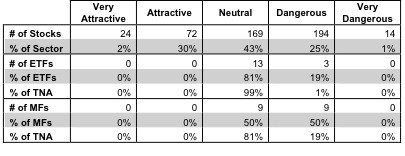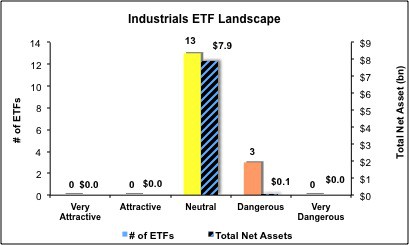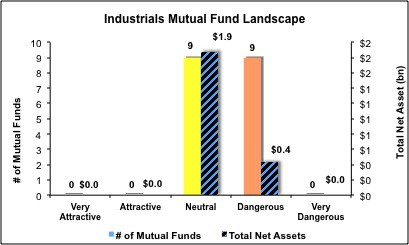The Industrials sector ranks fourth out of the ten sectors as detailed in my Sector Rankings for ETFs and Mutual Funds report. It gets my Neutral rating, which is based on aggregation of ratings of 16 ETFs and 18 mutual funds in the Industrials sector as of January 25th, 2013. Prior reports on the best & worst ETFs and mutual funds in every sector and style are here.
Figures 1 and 2 show the five best and worst-rated ETFs and mutual funds in the sector. Not all Industrials sector ETFs and mutual funds are created the same. The number of holdings varies widely (from 20 to 367), which creates drastically different investment implications and ratings. The best ETFs and mutual funds allocate more value to Attractive-or-better-rated stocks than the worst ETFs and mutual funds, which allocate too much value to Neutral-or-worse-rated stocks.
To identify the best and avoid the worst ETFs and mutual funds within the Industrials sector, investors need a predictive rating based on (1) stocks ratings of the holdings and (2) the all-in expenses of each ETF and mutual fund. Investors need not rely on backward-looking ratings. My fund rating methodology is detailed here.
Investors should not buy any Industrials ETFs or mutual funds because none get an Attractive-or-better rating. If you must have exposure to this sector, you should buy a basket of Attractive-or-better rated stocks and avoid paying undeserved fund fees. Active management has a long history of not paying off.
Get my ratings on all ETFs and mutual funds in this sector on my free mutual fund and ETF screener.
Figure 1: ETFs with the Best & Worst Ratings – Top 5
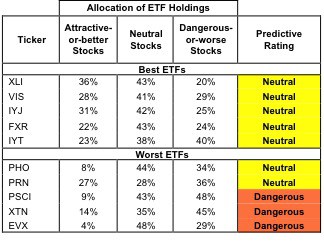 * Best ETFs exclude ETFs with TNAs less than $100 million for inadequate liquidity.
* Best ETFs exclude ETFs with TNAs less than $100 million for inadequate liquidity.
Sources: New Constructs, LLC and company filings
Five ETFs are excluded from Figure 1 because their total net assets (TNA) are below $100 million and do not meet our liquidity standards.
Figure 2: Mutual Funds with the Best & Worst Ratings – Top 5
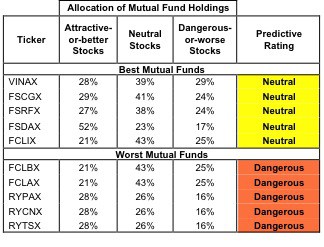 * Best mutual funds exclude funds with TNAs less than $100 million for inadequate liquidity.
* Best mutual funds exclude funds with TNAs less than $100 million for inadequate liquidity.
Sources: New Constructs, LLC and company filings
ICON Funds: ICON Industrials Fund (ICTRX, ICICX) is excluded from Figure 2 because its total net assets (TNA) are below $100 million and do not meet our liquidity standards.
Industrial Select Sector SPDR (XLI) is my top-rated Industrials ETF. Vanguard World Funds: Vanguard Industrials Index Fund (VINAX) is my top-rated Industrials mutual fund. Both earn my Neutral rating.
Market Vectors Environmental Services ETF (EVX) is my worst-rated Industrials ETF. Rydex Series Funds: Transportation Fund (RYTSX) is my worst-rated mutual fund. Both earn my Dangerous rating.
Figure 3 shows that 96 out of the 473 stocks (over 32% of the total net assets) held by Industrials ETFs and mutual funds get an Attractive-or-better rating. However, none of the 16 Industrials ETFs and none of the 18 Industrials mutual funds get an Attractive-or-better rating.
The takeaways are: mutual fund managers allocate too much capital to low-quality stocks and Industrials ETFs hold poor quality stocks.
Figure 3: Industrials Sector Landscape For ETFs, Mutual Funds & Stocks
It is quite unfortunate that ETF and mutual fund providers do not offer investors a single Attractive-or-better-rated fund especially when over 30% of the stocks get an Attractive-or-better rating.
Investors need to tread carefully when considering Industrials ETFs and mutual funds. No ETFs or mutual funds in the Industrials sector allocate enough value to Attractive-or-better-rated stocks to earn an Attractive-or-better rating. Focus on individual stocks instead.
As detailed in “Cheap Funds Dupe Investors”, the fund industry offers many cheap funds but very few funds with high-quality stocks, or with what I call good portfolio management.
Veeco Instruments, Inc. (VECO) is one of my favorite stocks held by Industrials ETFs and mutual funds and earns my Very Attractive rating. VECO creates a great deal of value for shareholders with a 19%ROIC last year. Still, investors appear to have been scared off by the slowing of its revenue growth even though its economic earnings margin continues to improve. At ~$32/share, VECO looks undervalued to me. That price translates into a price to economic book value ratio of 0.5, which means the market is predicting a permanent 50% decline in its profitability, an awfully pessimistic assumption.
Delta Air Lines, Inc. (DAL) is one of my least favorite stocks held by Industrials ETFs and mutual funds and earns my Very Dangerous rating. The gap between Delta’s reported earnings per share of $1.01 and its economic earnings per share of -$2.18 is a red flag for investors. Delta has not earned economic profits since 2008, and until it shows it can create shareholder value it is a risky buy. More details are in “Bail Out of DAL Before the Stock Crashes”.
415 stocks of the 3000+ I cover are classified as Industrials stocks, but due to style drift, Industrials ETFs and mutual funds hold 473 stocks.
Figures 4 and 5 show the rating landscape of all Industrials ETFs and mutual funds.
Our Sector Rankings for ETFs and Mutual Funds report ranks all sectors and highlights those offering the best investments.
Figure 4: Separating the Best ETFs From the Worst ETFs
Figure 5: Separating the Best Mutual Funds From the Worst Mutual Funds
Most investors in the industrials sector are at least putting their money in the Neutral rated ETFs and mutual funds. Still, the fact that 17% of Industrials mutual fund investors are allocating to Dangerous rated funds shows the need for more data on the quality of fund’s holdings.
Review my full list of ratings and rankings along with reports on all 16 ETFs and 18 mutual funds in the Industrials sector.
Sam McBride contributed to this report.
Disclosure: David Trainer and Sam McBride receive no compensation to write about any specific stock, sector or theme.

